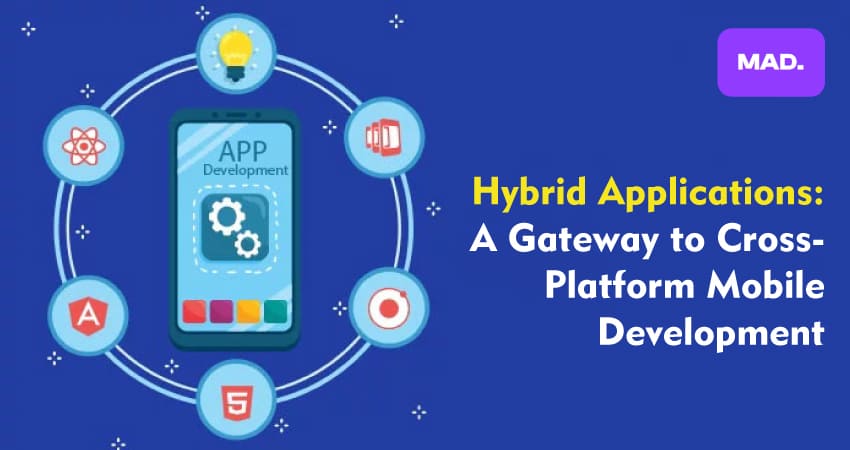New Jersey, USA
-
Location
-
Phone








Hybrid Applications: A Gateway to Cross-Platform Mobile Development

The digital age has ushered in a remarkable evolution in the development of mobile applications, particularly through the advent of hybrid solutions. Hybrid applications represent an innovative fusion of web technologies and native execution, standing out as a transformative approach in mobile app development. By enabling developers to write code once and deploy it across multiple platforms, hybrid apps simplify the development process, reduce costs, and shorten time to market. Whether you are a startup aiming to quickly launch your product, or an established business looking to expand your mobile presence without heavy investment, hybrid applications offer a versatile and efficient path forward. This approach not only accelerates the development cycle but also opens up a world of possibilities in maintaining a consistent user experience across various devices, making it an attractive choice for many businesses.
“The blog delves into hybrid applications, emphasizing their role as a cost-effective solution for cross-platform mobile development. By merging web technologies with native execution, hybrid apps allow developers to write once and deploy across multiple platforms, simplifying the development process and reducing costs. Key benefits include quicker time-to-market, simplified updates, and consistent user experiences across devices. Despite performance and access limitations, frameworks like PhoneGap and Ionic help mitigate these challenges. Successful implementations by companies like Instagram and Uber showcase the practical advantages of hybrid apps in enhancing user engagement and operational efficiency in today's digital landscape.”
Understanding Hybrid Applications
Definition of hybrid applications
Hybrid applications are a form of mobile app that blends elements of both native apps and web applications. At its core, a hybrid app is a web app built using HTML5, CSS, and JavaScript, which is then encapsulated within a native wrapper. This native wrapper enables the app to utilize and access the device-specific hardware features similar to a native app, such as the GPS, camera, or accelerometer. Since they can be installed on a device just like a native app, hybrid apps provide a user experience that can often rival native applications while allowing developers to write the code just once and still accommodate multiple platforms.
How hybrid apps combine web technologies with native features
Hybrid applications harness the power of web technologies and integrate them seamlessly with the unique features of mobile operating systems through what is known as a "webview". A webview essentially acts as a bridge connecting the web-based components of the app with the rich ecosystem of device-native features. By doing so, these applications not only deliver a consistent user interface across different operating systems but also tap into the native capabilities to enhance performance and user experience. For instance, a hybrid app can push notifications or access the device’s media tools, functions that are often critical for user engagement and functional richness.
Benefits of Hybrid Applications
Cost-effective development
One of the most appealing advantages of hybrid applications is their cost-effectiveness. Developing a hybrid app generally involves using a single codebase to cover multiple platforms (iOS, Android, etc.), which radically reduces development time and resources compared to building separate native apps for each platform. This unified development approach eliminates the need to hire multiple teams with different skill sets, therefore reducing overhead costs significantly. Furthermore, by leveraging free and open-source frameworks like Apache Cordova or React Native, companies can further minimize development costs while still producing competitive and robust mobile applications.
Faster time-to-market
Speed is a crucial factor in today’s fast-paced digital environment, and hybrid apps excel at ensuring a quicker time-to-market. Given that hybrid apps are developed with a single codebase, the amount of time from conceptualization to launch is significantly shortened. Developers can make a universal change that updates the application across all platforms simultaneously, rather than having to adjust codes for each platform individually. This not only speeds up the development process but also enables businesses to respond swiftly to market changes or user feedback, ensuring they stay ahead in the competitive curve.
Simplified maintenance and updates
Maintaining and updating apps is straightforward with hybrid applications, thanks to their singular codebase architecture. Traditional native apps require developers to roll out updates across multiple platforms, which can be time-consuming and cumbersome. In contrast, updates on hybrid apps can be deployed just like web pages — in one go — without the need for user intervention to update the app on their device. This simplicity extends to the maintenance phase as alterations or bug fixes that are made on the backend instantly propagate to all versions of the app, diminishing downtime and enhancing user satisfaction. This simplicity aids in managing the lifecycle of the app more effectively and ensures that users always have the latest functionalities and security updates without disruption.
By tapping into the versatility and capabilities of hybrid applications, companies can leverage their strengths for better scalability, efficiency, and user engagement, which are crucial for successful mobile applications in today’s technological landscape.
Challenges of Hybrid Applications
Building hybrid applications, while efficient and cost-effective, presents several challenges that developers must navigate. Despite the upper hand hybrid apps have in cross-platform development, certain limitations can affect their performance and functionality.
Performance Issues
One of the most cited drawbacks of hybrid applications is their performance. Since these apps do not interact with the mobile device’s operating system through native APIs but rather through a bridge, there can be noticeable lag and slower response times compared to native apps. This is particularly evident in graphically intense applications such as games or heavily interactive apps. Performance degradation can also occur because these apps typically rely on web technologies, which may not be as swift as the code executed in native environments.
Limited access to device features
Hybrid applications often face limitations in accessing device-specific features such as complex gestures, multi-touch events, sophisticated graphics, and detailed motion sensors. While recent advancements have reduced these gaps, native applications still have the upper hand when it comes to leveraging the total capacity of the underlying hardware. Developers might need to implement additional plugins or specific codes to bridge these gaps, which can complicate the development process and reduce efficiency.
Security concerns
The layered architecture of hybrid apps can introduce additional security vulnerabilities. Since hybrid applications depend heavily on web technologies, they inherit the security issues that plague web environments, such as cross-site scripting (XSS) and cross-site request forgery (CSRF). Furthermore, the use of third-party plugins to access native features could pose potential security risks if not properly vet out, as these plugins might access critical personal and device data.
Tools and Frameworks for Hybrid App Development
Embracing the right tools and frameworks can significantly alleviate some of the challenges associated with hybrid app development, enhancing capabilities, and ensuring greater security and performance. Here are some of the leading tools that developers rely on to create robust hybrid applications.
PhoneGap
PhoneGap, also known as Apache Cordovao, stands out as a popular choice among hybrid app developers. It allows developers to use standard web technologies like JavaScript, HTML5, and CSS3 to create applications that can run on multiple platforms using the same code base. What sets PhoneGap apart is its vast plugin library, which can help overcome some of the device access limitations typically associated with hybrid apps. These plugins connect directly with the native layer of the device, enabling more seamless interactions with the device’s features.
Ionic
Ionic is another heavyweight in the world of hybrid development frameworks, lauded for its user interface components that mimic native elements. Built on top of AngularJS and Apache Cordova, Ionic provides the tools necessary to develop high-quality, interactive apps. The framework supports an array of plugins and boasts a strong community, which constantly enhances its capabilities and functionalities. Developers appreciate Ionic for its scalability, immediate live updates, and integration capabilities which provide a nearly native experience to the user.
Xamarin
Xamarin takes a slightly different approach to hybrid app development by allowing developers to use C# along with .NET to build apps that can run across platforms while sharing code, logic, and data structures. This Microsoft-owned framework is known for producing more “native-like” apps with better access to device-specific features and higher performance levels. Xamarin also provides a seamless integration with Microsoft’s ecosystem, making it particularly advantageous for enterprises that are heavily embedded into Microsoft’s software and cloud services.
In the realm of developing hybrid applications, these frameworks and tools have proven instrumental in navigating cross-platform challenges efficiently, shedding light on an expanding horizon of possibilities for mobile app development.
Case Studies: Successful Hybrid Mobile Apps
The embracing of hybrid application development by leading tech companies illuminates its potential. Below are a few illuminating success stories.
Embracing hybrid technology has enabled Instagram, one of the most popular social media platforms, to maintain consistent user experience across multiple devices while speeding up the development process. This was particularly significant as it involved high volumes of data and complex interactions across different environments. By adopting a hybrid approach, Instagram was able to utilize web technologies that made it easier and quicker to add new features without compromising on performance. The hybrid model also facilitated a smoother integration of device-specific capabilities, such as camera functions and geolocation services, enhancing user engagement.
Twitter, a platform known for its real-time information exchange, also benefits significantly from hybrid app development. The hybrid nature of the Twitter app allows it to handle large volumes, diverse data types, and rapid content updates efficiently on multiple platforms. This approach has not only shortened the developmental cycles but also reduced costs by leveraging a single codebase to deploy across iOS, Android, and other platforms. Additionally, the seamless integration of native device features has improved the overall user experience, proving that high traffic apps can effectively utilize hybrid strategies.
Uber
Uber’s use of a hybrid app model showcases another robust implementation that effectively services millions of users worldwide. The hybrid application facilitates quicker updates and maintenance across all platforms, ensuring high performance and reliability. By combining the flexibility of web development with the robustness of native applications, Uber has optimized its app for varied operating environments, providing a seamless and efficient user interface. This strategy has been crucial in maintaining a consistent and reliable service that meets the demands of daily active users across different devices and operating systems.
Financial Management Tools for Startups
Managing finances effectively is central to the success of any startup. The right web-based applications can streamline accounting processes, improve financial visibility, and help manage cash flow efficiently. Among these, QuickBooks and FreshBooks stand out as essential tools for financial management in startup environments.
Tips for Developing High-Quality Hybrid Applications
The following practical tips can guide developers towards creating effective and efficient hybrid applications.
Optimize performance
Optimizing the performance of hybrid applications is vital for ensuring that they operate smoothly and efficiently on all platforms. Here’s how you can achieve this:
- Prioritize responsive design to ensure the app looks and operates well regardless of device screen size or resolution.
- Minimize the use of heavy libraries and frameworks when not essential.
- Implement lazy loading, where portions of the web resources are only loaded when necessary, which can enhance the app’s load time and overall performance.
- Use hardware-accelerated animations to ensure smoother transitions and interactions.
These steps will contribute significantly to providing a seamless user experience.
Test across multiple platforms
A thorough testing strategy is crucial for hybrid applications due to their cross-platform nature. Multi-platform testing ensures that the application provides a consistent user experience across all devices. Consider the following:
- Utilize emulators and physical devices to test the app’s performance across different environments.
- Implement continuous integration and delivery to automate testing and ensure issues are detected and resolved swiftly.
- Conduct user testing frequently to gather feedback and further refine the application.
Ensuring the app works flawlessly on each platform not only increases user satisfaction but also boosts your app’s credibility.
Follow best practices for security
Security is a top priority in hybrid app development, given the diverse environments in which the apps operate. Here are key practices to enhance security:
- Regularly update the app’s frameworks and libraries to protect against vulnerabilities.
- Store sensitive data securely using encryption and ensure that data transmission occurs over secure channels.
- Implement robust authentication mechanisms and consider using multi-factor authentication to protect user accounts.
By adhering to these security best practices, developers can safeguard user data and prevent potential threats, thereby maintaining trust and integrity in the app’s ecosystem.
Conclusion
In the world of app development, hybrid applications stand out as a robust solution bridging the gap between different operating systems. They empower businesses to reach a broader audience efficiently and economically, without compromising on the performance and user experience expected of native apps. As technologies evolve, the capabilities of hybrid frameworks are expanding, making it a compelling choice for anyone looking to deploy cross-platform mobile applications. Embracing hybrid technologies not only simplifies the development process but also accelerates market entry, ultimately boosting competitive advantage and fostering business growth.
MAD is a top app development company in the USA, a high-performance low-code platform that enables rapid and easy mobile app development compared to traditional coding methods.


